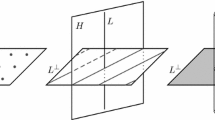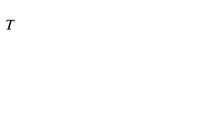Abstract
Cutting analysis of sets (scanning, laser exploration, etc.), when applied to epigraphs of functions and graphs of operators, gives rise to a rich calculus and provides a unifying approach to various operations in optimization and variational analysis.
Similar content being viewed by others
References
Artstein, Z.: Distribution of random sets and random selections, Israël J. Math. 46 (1983), 313–324.
Attouch, H.: Variational Convergence for Functions and Operators, Applicable Maths. Series, Pitman, London, 1984.
Attouch, H. and Thera, M.: Convergences en analyse multivoque et unilatérale, MATAPLI, Bulletin de liaison 36 (1993), 23–40.
Attouch, H. and Riahi, H.: Stability results for Ekeland's ε-variational principle and cone extremal solutions, Math. Oper. Res. 18(1) (1993), 173–201.
Attouch, H. and Wets, R.: Epigraphical analysis, in H. Attouch, J.-P. Aubin, F. Clarke, and I. Ekeland (eds), Analyse non linéaire, Gauthier-Villars, Paris, 1989, pp. 73–100.
Aubin, J.-P.: Mathematical Methods of Game and Economic Theory, North-Holland, Amsterdam, 1979.
Aubin, J.-P. and Frankowska, H.: Set-Valued Analysis, Birkhäuser, Basel, 1990.
Auslender, A. and Cominetti, R.: First and second order sensitivity analysis of nonlinear programs under constraint qualification condition, Optimization 21, (1990), 351–363.
Beer, G.: Conjugate convex functions and the epidistance topology, Proc. Amer. Math. Soc. 108 (1990), 117–128.
Beer, G. and Lucchetti, R.: Minima of quasi-convex functions, Optimization 20 (1989), 581–596.
Beer, G., Rockafellar, R.-T., and Wets, R.: A characterisation of epi-convergence in terms of convergence of level-sets, Proc. Amer. Math. Soc. 116 (1992), 753–761.
Borwein, J.: On the existence of Pareto Efficient Points, Math. Oper. Res. 81 (1983), 64–73.
Buttazzo, G.: Su una definizione generale dei Γ-limit, Boll. Un. Mat. Ital. 14-B (1977), 722–744.
Castaing, C. and Valadier, M.: Convex Analysis and Measurable Multifunctions, Lecture Notes in Math. 580, Springer-Verlag, New York, 1977.
Clarke, F.: Optimization and Nonsmooth Analysis, Wiley, New York, 1983.
Crouzeix, J.-P.: Contributions à l'étude des fonctions quasi-convexes, Thèse d'Etat, Université de Clermont, 1977.
Dal Maso, G.: An Introduction to Γ-Convergence, Birkhäuser, Basel, 1993.
De Giorgi, E.: Sulla convergenza di alcune successioni di integrali del tipo dell'area, Rend. di. Mat. 4(8) (1975), 277–294.
Ekeland, I.: On the variational principle, J. Math. Anal. Appl. 47 (1974), 324–353.
Elqortobi, A.: Inf-convolution quasi-convexe des fonctionnelles positives, Rech. Opérationnelle 26 (1992), 301–311.
Greco, G.: Teoria dos semifiltros, Seminario Brasileiro de Analise, Rio de Janeiro, 1985.
Hess, C.: Contributions à l'étude de la mesurabilité, de la loi de probabilité, et de la convergence des multifonctions, Thèse, Montpellier, 1986.
Modica, L.: Gradient theory of phase transitions and minimal interface criteria, Arch. Rat. Mech. Anal. 98, (1987), 123–142.
Moreau, J.-J.: Inf-convolution, sous-additivité, convexité des fonctions numériques, J. Math. Pures Appl. 49 (1970), 109–154.
Passty, G.: The parallel sum of non-linear monotone operators, Nonlinear Anal. TMA 10, (1986).
Penot, J.-P.: Miscellaneous incidences of convergence theories in optimization, and nonlinear analysis I: Behavior of solutions, Set-Valued Analysis 2 (1994), 259–274.
Poliquin, R.: An extension of Attouch's theorem and its application to second order epidifferentiation of convex composite functions, Trans. Amer. Math. Soc. 332 (1992), 861–874.
Rockafellar, R. T.: Convex Analysis, Princeton Univ. Press, Princeton, NJ, 1970.
Rockafellar, R. T.: First and second order epi-differentiability in nonlinear programming, Trans. Amer. Math. Soc. 307 (1988), 75–108.
Rockafellar, R. T. and Wets, R.: Set-valued analysis and subdifferential calculus, in preparation.
Seeger, A.: Analyse du second ordre de problèmes non différentiables, Thèse Université P. Sabatier, 1986.
Seeger, A. and Volle, M.: On a convolution operator obtained by adding level sets: classical and new results, Oper. Res. 29(2) (1995), 131–154.
Truffert, A.: Conditional expectations of integrands and random sets, Ann. Oper. Res. 30 (1991), 117–156.
Volle, M.: Convergence en niveaux et en épigraphes, C.R. Acad. Sci. Paris, Série I 299 (1984), 295–298.
Volle, M.: Quelques résultats relatifs à l'approche par les tranches de l'épi-convergence, Contributions à la dualité en optimisation et à l'épi-convergence, Thèse d'état, Université de Pau, 1986.
Author information
Authors and Affiliations
Rights and permissions
About this article
Cite this article
Attouch, H., Volle, M. Cutting and scanning methods in set-valued analysis I. An epigraphical and graphical calculus. Set-Valued Anal 4, 135–155 (1996). https://doi.org/10.1007/BF00425962
Received:
Accepted:
Issue Date:
DOI: https://doi.org/10.1007/BF00425962




